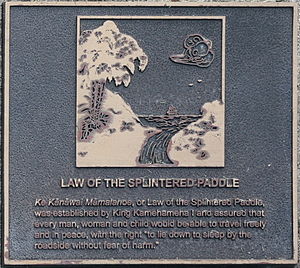- Kānāwai Māmalahoe
-
Kānāwai Māmalahoe, or Law of the Splintered Paddle (also translated Law of the Splintered Oar), is a precept in Hawaiian law, originating with King Kamehameha I in 1797. The law, "Let every elderly person, woman and child lie by the roadside in safety," is enshrined in the state constitution, Article 9, Section 10, and has become a model for modern human rights law regarding the treatment of civilians and other non-combatants[1]. It was created when Kamehameha was fighting in Puna. While chasing two fishermen (presumably with the intention to kill them), his leg was caught in the reef, and one of the fisherman, Kaleleiki, hit him mightily on the head with a paddle in defense, which broke into pieces. Luckily, Kamehameha was able to escape. Years later, the same fisherman was brought before Kamehameha. Instead of ordering for him to be killed Kamehameha ruled that the fisherman had only been protecting his land and family, and so the Law of the Splintered Paddle was declared[1][2].
The complete original 1797 law in Hawaiian:
Kānāwai Māmalahoe :
E nā kānaka,
Hewa nō, make.
E mālama ‘oukou i ke akua
A e mālama ho‘i ke kanaka nui a me kanaka iki;
E hele ka ‘elemakule, ka luahine, a me ke kama
A moe i ke ala
‘A‘ohe mea nāna e ho‘opilikia.English translation:
Law of the Splintered Paddle:
Oh people,
Break this law, and die.
Honor thy god;
respect alike [the rights of] people both great and humble;
May everyone, from the old men and women to the children
Be free to go forth and lay in the road (i.e. by the roadside or pathway)
Without fear of harm.Cultural context
It has been noted that Kānāwai Māmalahoe was not an invention of Kamehameha I, but rather an articulation of concepts regarding governmental legitimacy that have been held in Hawaiʻi for many prior generations. Countless stories abound in Hawaiian folklore of the removal of chiefs[3] – generally, but not always, through popular execution – as a result of mistreatment of the common people[4], who have traditionally been intolerant of bad government. As a shrewd politician and leader as well as a skilled warrior, Kamehameha used these concepts to turn what could have been a point of major popular criticism to his political advantage, while protecting the human rights of his people for future generations.
Modern relevance and controversy
Kānāwai Māmalahoe is well-known in Hawaiʻi. It has been applied to Hawaiian rights, elder law, children's rights, homeles advocacy, and bicyclist safety[5][6]. It also appears as a symbol of crossed paddles in the center of the badge of the Honolulu Police Department[7]. As such, particularly in consideration of the human rights concerns of the Hawaiian sovereignty movement (in which the State of Hawaii is generally viewed as de facto, or lacking legitimacy[8]), Kānāwai Māmalahoe has been the subject of extended controversy[9][10]. Issues surround the use of the law of Kamehameha I in the State's constitution and the treatment of homeless persons, especially those of native descent[11][12], many of whom reside upon ancestral lands that have been converted to public use or private property under State law[13].
References
- ^ a b http://www.hawaii.edu/uhelp/files/LawOfTheSplinteredPaddle.pdf
- ^ Hawaiian Historical Legends: XVII. The Law of the Splintered Paddle. Sacred-texts.com. Retrieved on 17 October 2011.
- ^ Hawaiian Mythology: Part Three. The Chiefs: XXVIII. Usurping Chiefs. Sacred-texts.com. Retrieved on 17 October 2011.
- ^ [1][dead link]
- ^ COMMENT: Ke Kanawai Mamalahoe: Equality in Our Splintered Profession. Litigation-essentials.lexisnexis.com. Retrieved on 17 October 2011.
- ^ JK Endurance: Cool Hawaii Biking Jersey @RideAloha #bikejersey. Jkendurance.blogspot.com (2011-07-21). Retrieved on 17 October 2011.
- ^ The HPD Badge. Honolulupd.org (2011-07-17). Retrieved on 17 October 2011.
- ^ Part 3: Hawaii vs. U.S. Imperialism. Pinkyshow.org. Retrieved on 17 October 2011.
- ^ Some Aspects Of Law In Hawaii. Paclii.org. Retrieved on 17 October 2011.
- ^ Culture and educational policy in ... – Maenette Kapeʻahiokalani Padeken Ah Nee-Benham, Ronald H. Heck – Google Books. Books.google.com. Retrieved on 17 October 2011.
- ^ Culture and educational policy in ... – Maenette Kapeʻahiokalani Padeken Ah Nee-Benham, Ronald H. Heck – Google Books. Books.google.com. Retrieved on 17 October 2011.
- ^ http://hawaii.gov/gov/newsroom/executive-orders/EO11-21.pdf
- ^ Mokuleia Beach residents not budging to vacate park – Hawaii News Now – KGMB and KHNL Home. Hawaii News Now (2008-06-17). Retrieved on 17 October 2011.
- REDIRECT Law of the Splintered Paddle
Categories:- Hawaii law
- Law stubs
- Hawaii stubs
Wikimedia Foundation. 2010.

